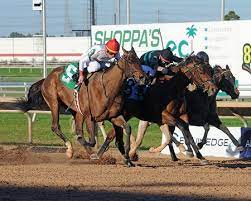Introduction:
Horse racing, a centuries-old sport that transcends time and borders, is a breathtaking display of grace, power, and unbridled passion. From the thunderous gallop of hooves on the track to the strategic finesse of skilled jockeys, horse racing is more than a sport; it’s an exhilarating spectacle that has woven itself into the fabric of human history. In this exploration, we embark on a journey through the realms of history, the elegance of thoroughbreds, the artistry of jockeys, and the intoxicating atmosphere of the racetrack, to unravel the timeless allure of horse racing. Read more filièreturf.
A Storied Legacy:
The roots of horse racing extend deep into antiquity, with chariot races and mounted contests gracing the annals of history. However, the formalized structure of modern horse racing emerged in 17th-century England, laying the foundation for the sport as we know it today. From its aristocratic origins, horse racing evolved into a global phenomenon, captivating audiences across continents and cultures.
Three primary forms of horse racing dominate the contemporary scene: flat racing, steeplechase, and harness racing. Flat racing, a symphony of speed and agility, unfolds on level tracks where sleek thoroughbreds showcase their prowess. Steeplechase injects an element of daring, as horses navigate obstacles, and harness racing adds a unique dimension with horses pulling two-wheeled carts.
The Elegance of the Thoroughbred:
At the heart of horse racing lies the thoroughbred, a breed synonymous with speed, endurance, and unmistakable elegance. These magnificent creatures, meticulously bred for generations, embody the pinnacle of equine athleticism. The sleek lines, muscular grace, and distinctive gallop of a thoroughbred paint a portrait of power in motion.
Thoroughbred racing, often dubbed the “Sport of Kings,” is a dance of precision and strength. The jockey, perched atop the thoroughbred, becomes a partner in this dance, guiding the horse with subtle cues and expert horsemanship. The relationship between jockey and horse is a delicate synergy, where trust and communication pave the way for victory.
The Artistry of Jockeys:
While the thoroughbred captures attention with its beauty and speed, the jockey is the maestro orchestrating the race. Weighing little more than a feather, jockeys are athletes of extraordinary skill and courage. Their ability to read the race, make split-second decisions, and coax the best performance from their equine partner is a testament to their artistry.
Jockeys, clad in vibrant silks, become one with the horse as they navigate the twists and turns of the track. The subtle shifts in weight, the gentle taps of the whip, and the expert handling of the reins are all part of the intricate language spoken between rider and steed. The success of a race hinges not only on the speed of the thoroughbred but also on the strategic brilliance of the jockey.
The Heartbeat of the Racetrack:
The racetrack itself is a living entity, pulsating with energy and anticipation. As the starting gates swing open, the thunderous cadence of hooves echoes through the air, setting the stage for the drama that is about to unfold. The atmosphere on race day is electric, with spectators drawn into the heartbeat of the racetrack.
The roar of the crowd, the flash of colorful jockey silks, and the relentless pursuit of the finish line create an immersive experience that transcends the physical boundaries of the racetrack. The collective gasp as the horses round the final turn, the surge of excitement as they sprint toward the finish, and the jubilation or heartbreak etched on the faces of spectators amplify the emotional crescendo of the race.
Traditions and Iconic Races:
Horse racing is steeped in tradition, each race a narrative woven with customs and rituals. The Kentucky Derby, an American institution, is synonymous with the grandeur of Churchill Downs, the iconic Twin Spires, and the coveted blanket of roses bestowed upon the victor. Royal Ascot, a jewel in British racing, marries the regal with the refined, featuring a royal procession and a strict dress code.
Iconic races like the Grand National, the Melbourne Cup, and the Dubai World Cup have become global landmarks, transcending their sporting significance. These races are more than competitions; they are cultural celebrations that unite people in their shared appreciation for the majesty of horse racing.
Challenges and Evolution:
Despite its enduring appeal, horse racing faces challenges that demand careful consideration. Concerns about the welfare of racehorses, particularly injuries and fatalities, have prompted a reevaluation of industry practices. Ethical treatment, responsible breeding, and the post-racing life of retired horses are crucial aspects that the racing community grapples with.
The industry’s response involves a commitment to change and improvement. Advances in veterinary care, stricter regulations, and initiatives to ensure responsible breeding and aftercare reflect a conscientious effort to prioritize the well-being of both horses and jockeys. The evolution of horse racing is a continuous process, seeking to strike a balance between tradition and progressive ethical standards.
Conclusion:
In the grand tapestry of sports and entertainment, horse racing stands as a masterpiece that transcends generations. It is an art form, a display of power, and a celebration of the timeless bond between humans and horses. As horse racing continues to evolve, it must embrace responsible practices to secure a sustainable future while preserving the magic that has enchanted audiences for centuries. The symphony of speed, the elegance of thoroughbreds, and the artistry of jockeys collectively ensure that the allure of horse racing will echo through time, captivating hearts and minds for generations to come. See more casacors.

